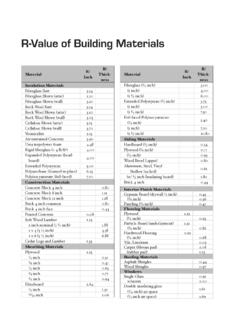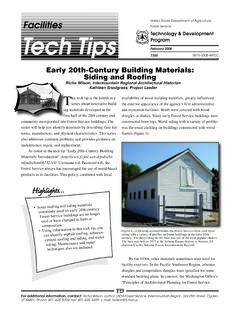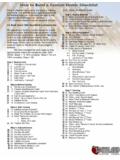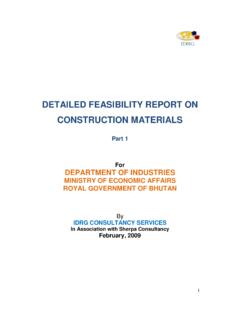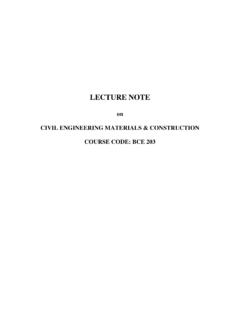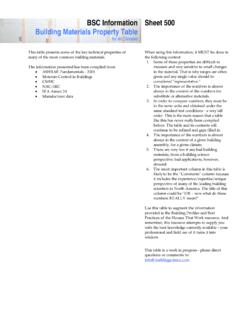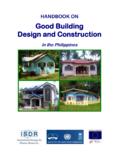Transcription of Shaping Buildings for the Humid Tropics - Green Home …
1 1 Shaping Buildings for the Humid Tropics Shaping Buildings for the Humid Tropics : Cultures, Climate, and Materials Patti Stouter, ASLA. First edition, November, 2008. Online version available at Please share these self-help guidelines and let us know how to improve them. 2 Shaping Buildings for the Humid Tropics TABLE OF CONTENTS: 3 Introduction 4 Buildings FOR PEOPLE. 6 PLANNING FOR COMFORT: 6 Ventilation 7 Shading 9 Plantings 10 Insulation 10 DESIGN WITH NATURE: 12 Plants 13 Water and Soil 15 LIGHTWEIGHT building MATERIALS.
2 18 COMPARING TYPES OF MASONRY. 20 building WITH MASONRY. 24 Acknowledgments 25 The Author 26 Bibliography 28 Photo Credits 3 Shaping Buildings for the Humid Tropics Introduction Buildings for hot- Humid climates should be comfortable in heat and dampness. The humidity is usually above 60% and often nearly 100% in many regions. Simple, low-cost Buildings can be cool, dry, and mold-free if they are carefully planned. Buildings in other areas have conquered cold and dangers like earthquakes. These same new Buildings are often uncomfortable and overpriced in the Tropics .
3 Large areas in the Tropics , like much of central Africa and central South America, are free from serious earthquakes or tsunamis. People in the Tropics have to conquer torrential rains and termites. They shouldn't throw money away building for a hazard that they don't have. People also live differently in the Tropics than in colder regions, and differently than they did 100 years ago. Old traditional Buildings don't fit the way they live now, because cultures have changed. New Buildings should fit the ways people live in the Tropics .
4 This booklet and its sequels, Earthbag building in the Humid Tropics and Simple Earth Buildings for the Humid Tropics have some guidelines that can help you plan smarter for your beautiful and challenging part of the world. A thatch and earthbag performance building in South Africa. 4 Shaping Buildings for the Humid Tropics Buildings For People Old Buildings responded to the weather, the economy, and the people. The relationships and work patterns of the people lasted longer than their Buildings . The process of making Buildings taught young people how to behave and to understand their world.
5 It was a basic personal skill, so houses seemed like a part of their own bodies. Much has changed, and old shapes may no longer work with how people live today. People move, get different jobs, but expect houses to last. People spend much more time inside, need more room for belongings, and may need to lock up their houses. Right: A modern apartment building in Cameroon. How do people use Buildings ? In many city areas people still spend a lot of time outside and want porches or pavilions that shade and shelter them from rain.
6 But they also want a good wall or fence to keep them safe. Many people outside of the biggest cities still prefer to cook over wood fires. This is not just because they lack a 'better stove.' Wood may be cheaper, or free. In some places small fires burn inside to give light and to keep the mosquitoes out and preserve roof rafters and thatch. Separate wash and cooking Buildings are often used to keep moisture and heat out of the main building . Showers, laundry areas, and kitchens can be located where breezes will blow extra moisture and heat away, or can be separated by breezeways.
7 Locating them within the same walls may be less costly, but they could have outside access or be separated from the rest of the building . Above left: An outdoor workshop for a craftsman. Above right: Selling and visiting outdoors. 5 Shaping Buildings for the Humid Tropics Buildings also have meanings. The only way to find out what they are is to ask the locals. Show them photos of traditional building details or styles. Ask what they think of them, and how these kinds of Buildings make them feel. Above left: Roofs of the powerful In northwest Cameroon.
8 Above right: An Arabic arch motif for religion or ethnicity? Below right: A doorway at the mosque in Djenne, Mali. Among some people pinnacles or buttresses added to courtyard walls symbolize protection because they look like the ancient shrines called 'pillars of the dead' and the pinnacled mosques. 1. These sloping pier shapes could be easily used in a new building . Many peoples had round Buildings until concrete block made them too difficult to build. To some round Buildings may feel more like home, and remind them of their village background.
9 Others may now prefer rectangular houses because these are the house types of 'rich people'. People's houses reflect who they are. They try to make their houses attractive by how they finish doors and windows or how they paint. Many traditional house decorations are very beautiful and make life more pleasant for those who live in them. Above left: A tiled building stays bright without refinishing, near Bamenda, Cameroon. Above right: An interior carved earthen pillar from Niger. 1 Crouch and Johnson (2001). Traditions in Architecture.
10 Oxford: Oxford University Press p. 27. 6 Shaping Buildings for the Humid Tropics Planning for Comfort Buildings in hot- Humid climates need to be different from those in hot-dry climates. Heavy Buildings can moderate the temperature in dry areas. In places where the climate alternates between dry and wet seasons, heavy Buildings are comfortable in the dry season, but during the rainy season are damaged by mold growth caused by condensation. Buildings in Humid climates are also subject to more intense attack by insects, and materials rust and decay much more quickly than in other Hot- Humid inland areas of the world have high humidity and temperatures that rise and fall slightly every day.
